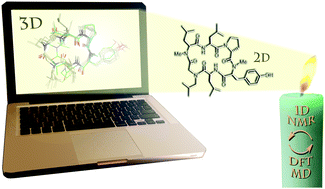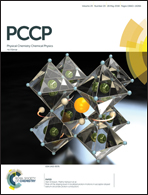Using 1H and 13C NMR chemical shifts to determine cyclic peptide conformations: a combined molecular dynamics and quantum mechanics approach†
Abstract
Solving conformations of cyclic peptides can provide insight into structure–activity and structure–property relationships, which can help in the design of compounds with improved bioactivity and/or ADME characteristics. The most common approaches for determining the structures of cyclic peptides are based on NMR-derived distance restraints obtained from NOESY or ROESY cross-peak intensities, and 3J-based dihedral restraints using the Karplus relationship. Unfortunately, these observables are often too weak, sparse, or degenerate to provide unequivocal, high-confidence solution structures, prompting us to investigate an alternative approach that relies only on 1H and 13C chemical shifts as experimental observables. This method, which we call conformational analysis from NMR and density-functional prediction of low-energy ensembles (CANDLE), uses molecular dynamics (MD) simulations to generate conformer families and density functional theory (DFT) calculations to predict their 1H and 13C chemical shifts. Iterative conformer searches and DFT energy calculations on a cyclic peptide–peptoid hybrid yielded Boltzmann ensembles whose predicted chemical shifts matched the experimental values better than any single conformer. For these compounds, CANDLE outperformed the classic NOE- and 3J-coupling-based approach by disambiguating similar β-turn types and also enabled the structural elucidation of the minor conformer. Through the use of chemical shifts, in conjunction with DFT and MD calculations, CANDLE can help illuminate conformational ensembles of cyclic peptides in solution.



 Please wait while we load your content...
Please wait while we load your content...
